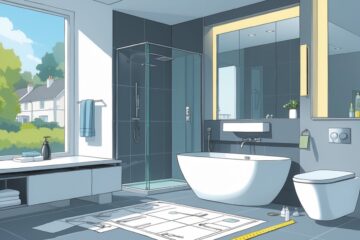Choosing the perfect colour palette for your home can transform your living space, making it both visually appealing and comfortable. Understanding how colours interact with your furniture, decor, and overall design is crucial. Start by considering your personal style and the atmosphere you want to create. Whether you prefer calming blues or vibrant reds, your selection should resonate with your taste and lifestyle.

Lighting plays a significant role in how colours appear throughout the day. It’s essential to see how your chosen hues look under different lighting conditions. This ensures harmony between your colour palette and interior design, helping your surroundings feel cohesive. Don’t forget to factor in your existing furniture and decor, which should complement your palette seamlessly.
For a cohesive look, try the 60-30-10 rule. Use your main colour for 60% of the room, a secondary colour for 30%, and accent shades for the remaining 10%. This method, as discussed by design experts, provides balance and highlights key areas in your home, creating a stunning visual impact. For more ideas, check out sites like Homes & Gardens and Real Simple.
Understanding Colour Theory
Choosing the perfect colour palette for your home involves understanding the principles of colour theory. This includes knowledge about the colour wheel, colour temperatures, and how different hues can affect mood and atmosphere.
The Basics of Colour Theory
Colour theory encompasses the basic principles of how colours mix, match, and contrast. This starts with primary colours: red, yellow, and blue. These hues can’t be created by mixing other colours but are the source of all other colours.
Secondary colours result from mixing primary colours: red and yellow make orange, blue and yellow make green, and red and blue make purple. Tertiary colours are created by mixing primary and secondary colours. Understanding these basics helps you create harmonious colour schemes, with tones that work well together.
The Colour Wheel in Practice
The colour wheel is a fundamental tool in design, illustrating the relationship between colours. It organises colours in a circular format showing how they transition into one another. Complementary colours are opposite each other on the wheel, like blue and orange, creating vibrant contrast.
Analogous colours sit next to each other on the wheel, such as green, yellow-green, and yellow. These combinations are harmonious and pleasing to the eye. Use the colour wheel to find the right balance of dominant, secondary, and accent colours, ensuring you create a balanced and visually appealing space.
Colour Temperatures and Moods
Colours can be divided into warm and cool categories, each bringing different atmospheres to a room. Warm colours like red, yellow, and orange evoke energy and warmth, suitable for social spaces like living rooms and kitchens.
Cool colours, including blue, green, and purple, are calming and soothing, ideal for bedrooms and bathrooms. Colour psychology plays a significant role here, as different hues can influence how a space feels. Understanding the temperatures of colours allows you to tailor the mood and atmosphere to each room in your home.
Selecting a Cohesive Colour Scheme
Creating a cohesive colour scheme for your home involves achieving harmony and balance across all rooms through thoughtful selection and placement of colours. This approach ensures continuity and visual appeal.
Whole House Harmony
To achieve harmony throughout your home, consider your entire house as a single connected space. Start by selecting a base colour or a small palette of complementary colours that will flow through different rooms. For instance, choosing colours for your home as a whole ensures each space feels interconnected.
Using a primary colour in communal areas like the living room and hallway can form a foundation, while variations of this colour can be employed in bedrooms and bathrooms. You may incorporate soft neutral tones that transition seamlessly between spaces, creating a relaxing environment. Another approach is to use a single accent colour in varying shades to tie different rooms together, promoting unity and coherence.
Balancing Colours and Contrast
Balance and contrast are pivotal in crafting a visually appealing colour scheme. Even within a cohesive scheme, varying light and dark shades of your chosen colours create visual interest. Implementing contrast, such as pairing deep, rich hues with lighter, more neutral tones, can highlight architectural features and draw attention to focal points.
For a cohesive look, consider using earthy colours combined with neutral shades. This combination works well in modern and mid-century designs, where forest greens or mustard yellows paired with whites or beiges create a balanced and inviting atmosphere.
Experiment with contrasts in furnishings and decor. Dark wooden furniture against light walls or vibrant cushions on a neutral sofa exemplifies balance without overwhelming the space. This strategy maintains harmony while ensuring each room has its own unique character.
Choosing Colours for Different Spaces
Selecting the right colours for each room in your home can drastically impact the mood and functionality of each space. Whether it’s enhancing the tranquillity of bedrooms, creating a dynamic atmosphere in living areas, or ensuring practicality in bathrooms and kitchens, the right colour choice is essential.
Creating Atmosphere in Living Areas
Living areas benefit from colours that create a welcoming and warm environment. Earthy shades such as terracotta and olive green can make the space feel snug and cosy. If you have ample natural light, consider cool tones like soft blues and greys to keep the room airy.
An accent wall in a bold colour can add depth and interest without overwhelming the space. To enrich the atmosphere, match your wall colours with your furnishings and lighting. Soft whites and creams as a backdrop can highlight colourful decor items, creating a well-balanced setting.
Colours for Relaxing Bedrooms
Bedrooms should be a sanctuary of calm and relaxation. Opt for shades that promote serenity, such as muted blues, gentle greens, and soft lavenders. These colours are known to have calming effects, making them ideal for restful spaces. Neutral tones like beige and taupe also work well for a restful ambiance.
Maximise the effect of your chosen colours by considering the room’s natural light. Light colours can make small spaces feel larger and more open. Incorporate darker shades through accessories or an accent wall to add dimension without compromising the tranquil setting. Use a mood board to experiment with different palettes and find the best combination for a soothing bedroom.
Functional Colours for Bathrooms and Kitchens
In functional areas like bathrooms and kitchens, colour choices need to reflect both practicality and style. Light and bright hues such as whites, light greys, and pastels can make these often smaller spaces appear larger and cleaner.
Consider durable finishes for walls that can withstand moisture and frequent cleaning. In kitchens, bold colours like navy or forest green can add sophistication, while lighter shades can keep the space feeling fresh and clean. Enhance the colour scheme with complementary tiles and countertops, and use colour-coordinated accessories to tie the look together seamlessly.
Incorporating Patterns, Textures, and Accessories
Creating a harmonious and stylish home involves integrating patterns, textures, and accessories seamlessly. These elements add depth and character, making your space unique and inviting.
Using Textiles and Wallpapers
Textiles and wallpapers are great ways to introduce patterns and textures into your home. For instance, floral or geometric wallpapers can set the tone for the entire room. You should consider combining large and small patterns to create visual interest without overwhelming the space.
Incorporate a variety of textures through items such as rugs, cushions, and throws. A plush velvet sofa paired with a woven rug can create a cosy and inviting atmosphere. Don’t shy away from experimenting with different materials like silk, linen, and wool to add tactile diversity.
When selecting textiles, focus on coordinating colours to ensure a cohesive look. Use similar hues for wallpapers and cushions to tie the room together effortlessly. Mix and match but ensure there is balance by keeping the colour palette consistent.
Selecting Complementary Accessories
Accessories are the finishing touches that bring your design together. They can include artwork, vases, and decorative pieces that reflect your personality. When choosing accessories, think about how they interact with your patterns and textures.
Display patterned throws or pillows in colours that complement your wall treatments and larger furniture pieces. Choose artwork that echoes the patterns or colours from your textiles to create a unified look. Mirrors with textured frames or sculptural decor items can add an extra layer of sophistication.
Plant life, such as potted plants or floral arrangements, also serves as excellent accessories. They introduce a natural texture and fresh colours that enhance virtually any interior design. Smaller details like patterned photo frames or textured ceramics contribute to the overall aesthetic without overwhelming the space.
Finding Inspiration and Keeping Up with Trends
Choosing the perfect colour palette for your home requires drawing inspiration from a variety of sources and staying current with both modern and traditional influences. This will help to create a space that is visually appealing and cohesive.
Sources of Colour Inspiration
One of the best ways to find colour inspiration is to look to nature. The colour combinations found in the outdoors – the green of leaves, the blue of the sky, or the warm tones of sand and sunsets – can offer beautiful and harmonious palettes.
Pinterest and Instagram are excellent platforms for discovering current trends and innovative colour schemes. Following interior designers and home décor accounts can provide a wealth of ideas.
Magazines and blogs dedicated to interior design are also valuable resources. They often feature the latest trends and timeless classics, presenting a curated view of what’s popular and stylish. Checking out articles such as 6 Ways to Find the Perfect Colour Palette can provide specific advice and tips.
Modern and Traditional Influences
Incorporating modern and traditional influences ensures your home is stylish yet timeless. Modern influences may include sleek, minimalist designs with a focus on neutral colours like grey and white. This approach can be observed in tips from designers who suggest using medium to light grey walls with white trim, coupled with navy accents, as seen in Real Simple.
Traditional influences might incorporate richer, more saturated colours and historical palettes. These could be inspired by travel and cultural heritage, incorporating classic elements that stand the test of time. Combining modern with traditional elements allows for a balanced and eclectic aesthetic that feels both fresh and rooted.
Practical Tips and Expert Advice
When choosing a colour palette for your home, consulting a professional can provide valuable insights, while DIY strategies offer flexibility and a personal touch.
Consulting a Colour Expert
Engaging with an interior designer or colour consultancy service can save you time and ensure cohesion throughout your home. Experts from companies like Dulux and Farrow & Ball can recommend paint colours based on your decor choices and lighting conditions.
A professional might suggest a monochromatic or analogous colour scheme, using colour combinations that complement each space’s function. Zachary Wheeler, for instance, suggests medium to light grey walls paired with white ceilings and trim. Experts can offer tailored advice, helping you select secondary colours and accents that align with your style.
DIY Colour Selection Strategies
For those who prefer a hands-on approach, utilising tools like paint swatches and samples is essential. You can use applications like the Dulux Visualizer which allows you to see potential wall colours in your space using augmented reality.
Consider your favourite colours and how different paint colours would interact with the existing decor. Try a few combinations using samples from brands like Benjamin Moore or Little Greene. Testing colours in various lighting conditions ensures they look good throughout the day. Keep in mind the 60-30-10 rule: 60% dominant colour, 30% secondary colour, and 10% accent colour for balance.


